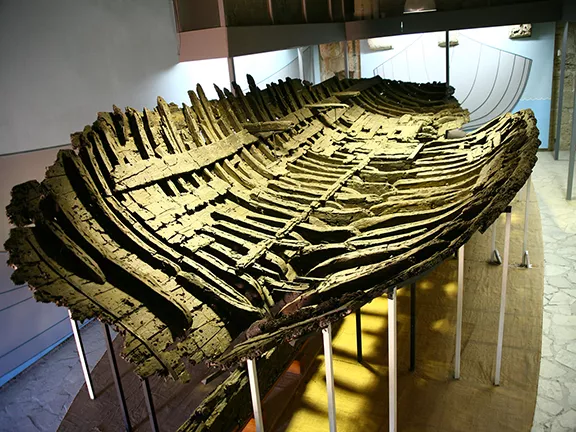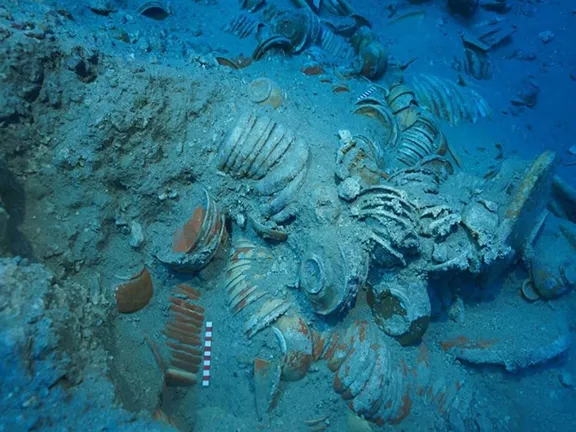Roman Era Shipwrecks in the Mediterranean
The Mahdia Shipwreck: Masterpieces of Art and History Recovered from the Deep
Examining the source of the Mahdia shipwreck's lead ingots through isotopic analysis. Learn how this 2,000-year-old metal, once Roman cargo, is now a crucial, radiation-free shield for cutting-edge neutrino and particle physics experiments.
By Nick Nutter on 2025-11-1 | Last Updated 2025-11-1 | Roman Era Shipwrecks in the Mediterranean
This article has been visited 365 times

Mahdia Dive Ship 1907
Mahdia Shipwreck 80–70 BC
The Mahdia shipwreck, discovered off the coast of Tunisia in June 1907 by Greek sponge fishermen, represents one of the most significant finds in the history of underwater archaeology. This sunken vessel carried a remarkable cargo of Greek artwork and architectural elements, which offer invaluable insights into the trade of luxury goods during the Hellenistic period.
Do you enjoy my articles? For your reading pleasure, this website does not carry third party ads. You could help me write more articles by buying me a cup of coffee.
Discovery and Excavation History
Greek sponge divers, working near the town of Mahdia, located the wreck at a depth of approximately 40 metres (Merlin, 1911). They brought the first pieces of its precious cargo to the surface, alerting authorities to the site's importance.
The initial, state-led excavation of the wreck took place shortly after its discovery, from 1907 to 1913. The operation was led by the French archaeologist Alfred Merlin and proved to be immensely challenging due to the depth of the site, requiring innovative, deep-sea diving techniques for the time. This initial campaign successfully recovered the majority of the major artwork and architectural pieces (Merlin, 1911; Hellenkemper Salies et al., 1994).
While the early work recovered much of the artistic cargo, the site has seen renewed scholarly interest. Subsequent studies and publications, such as a major collaborative effort in the 1990s (Hellenkemper Salies et al., 1994), thoroughly examined the finds and their context, highlighting the wreck's significance. These later investigations, combined with modern underwater archaeology, have refined the interpretation of the cargo and the wreck itself (Velentza, 2023).
Ship Construction Details


Mahdia reconstruction
Archaeological investigation reveals the Mahdia vessel employed the dominant architectural design common in Mediterranean naval architecture during the Hellenistic period and the Roman Republic, featuring a tripartite structure of a keel, planking, and framing (Hellenkemper Salies et al., 1994). This structural system was characterised by:
Carvel Planking: The hull planks were assembled using mortise-and-tenon joints, a common feature of Hellenistic shipbuilding.
Framing: The internal framing system featured alternating floor timbers and half frames, which were generally fixed to the planking with clenched nails driven into wooden dowels.
Sheathing: The hull remains exhibited evidence of a reinforcing lead sheathing. The use of lead sheathing on hulls was a protective measure seen on ships until about the 1st century BC (Hocker, 1995a). The presence of olive wood wedges has also been noted (Nieto Prieto et al., 1989).
The ship was a large Roman freighter, capable of transporting the immense and heavy cargo it carried (Merlin, 1911).
Cargo, Date, and Destination
The Mahdia shipwreck carried an exceptional cargo, predominantly composed of Greek luxury goods and architectural elements. This diverse assemblage of material culture attests to an extensive trade in ancient Greek antiquities (Hellenkemper Salies et al., 1994; Bauchhenß, 1994).
Details and Source of the Cargo
The haul consisted of three main categories:
Sculpture: The most famous finds included numerous bronze and marble statues, alongside decorative elements and reliefs (Merlin, 1911). The stylistic diversity of the recovered artwork suggests they formed part of a large-scale collection or shipment, perhaps representing a 'cultural memory bank' where various styles were available (Eck et al., 2015). Architectural Elements: The cargo included approximately 70 marble columns, capitals, and other architectural components (Davies, 2023). Analysis suggests that these elements were potentially looted from Athens, intended for re-use or display in a Roman context (Davies, 2023). Utilitarian Items: The vessel also carried less prominent, yet important, cargo such as amphorae and hundreds of lead ingots (Merlin, 1911). The lead ingots contribute to the study of the ancient seaborne lead trade (Brown, 2011).
Analysis and Provenance of the Lead Ingot Cargo
The Mahdia hold contained a significant quantity of lead ingots, a commercial cargo that provides crucial data for understanding ancient trade and metallurgy. Scientific analysis of this utilitarian metal has been undertaken, primarily through Lead Isotope Analysis (LIA), to pinpoint the source of the raw material.
Provenance Determination
The lead ingots recovered from the Mahdia wreck, have undergone rigorous isotopic analysis to determine their geographic origin. This technique creates a distinct "fingerprint" of the lead, which researchers then compare against a database of known ancient ore deposits across the Mediterranean.
Exclusion of Western Sources: The primary analysis has established that the Mahdia lead ingots do not share an isotopic signature with the major Roman-era lead sources in the Western Mediterranean, such as the vast deposits of Sierra Morena in modern-day Spain or the mining regions of the Massif Central in France. Likely Eastern/Central Mediterranean Source: The isotopic data strongly suggests an origin in the Eastern Mediterranean, the Balkans, or possibly Sardinia. This finding is significant as it supports the archaeological conclusion that the vessel was sailing from a Greek port (likely Piraeus) on a route that would have placed it near these sources, either for direct collection or trans-shipment.
This analysis confirms the commercial aspect of the ship’s journey, demonstrating that it carried both highly valuable works of art and bulk raw material, both of which were in high demand in Roman Italy.
Unforeseen Modern Utility
A remarkable and unexpected result of this analysis is the modern utility of this ancient metal. Lead recovered from Roman shipwrecks is highly prized by particle physics research due to its exceptional radiological purity.
Radiation Shielding: Having been shielded by deep seawater for over 2,000 years, the lead has lost almost all traces of the naturally occurring radioactive isotope, lead-210, which decays over centuries. This near-total absence of radioactivity makes the ancient metal an ideal material for constructing internal shielding for ultra-sensitive detectors, such as those used in neutrino observatories (like the CUORE and RES-NOVA experiments in Italy) where even the slightest background radiation would corrupt results. The lead has transitioned from an ancient commodity to a cutting-edge scientific tool, helping physicists explore the mysteries of the universe.
Date of Sinking and Destination
Based on the coins, lamps, and pottery recovered from the wreck, researchers established the sinking date to the first century BC, specifically around 80–70 BC (Davies, 2023).
The nature of the luxury and architectural cargo has led to a strong consensus regarding the ship's trajectory. The vessel was almost certainly sailing from , with the artwork likely originating from Athens or other Greek centres, and heading for a presumed destination in Italy, specifically a major Roman market (Merlin, 1911; Davies, 2023). A storm blew the ship off course, causing it to sink off the coast of what is now Tunisia (Merlin, 1911). The cargo’s composition reflects the Roman elite’s demand for Greek art and materials, indicating the Mahdia shipwreck was transporting items that would have served to embellish a luxurious public or private building in Rome or another wealthy city in Italy (Merlin, 1911; Davies, 2023).
Viewing the Artefacts
The main collection of artifacts recovered from the Mahdia shipwreck can be seen in two locations in Tunisia.
Bardo National Museum (Musée National du Bardo), Tunis
This museum holds the vast majority of the shipwreck's high-value cargo, which is considered one of the most important collections of Greek art ever recovered from an ancient shipwreck. Key artifacts you can see here include:
Bronze Sculptures: Including a famous statuette of a Satyr and the bronze herm (a stylized pillar with a head) signed by the sculptor Boethus of Chalcedon.
Marble Sculptures: Various pieces, including a bust of Aphrodite.
Decorative Elements: Such as bronze couch fittings, candelabra, and kraters (large mixing bowls) decorated with Dionysiac reliefs.
The museum also houses a famous replica of the bow of the Mahdia wreck.
Mahdia Archaeological Museum, Mahdia
Located near the site of the wreck itself, this smaller museum features a dedicated section on underwater archaeology, including artifacts from the Mahdia shipwreck.
References
Bauchhenß, G. (1994). Totenmahlreliefs. In G. Hellenkemper Salies, H.-H. von Prittwitz und Gaffron, & G. Bauchhenß (Eds.), Das Wrack: Der antike Schiffsfund von Mahdia (pp. 378–387). Rheinland-Verlag.
Brown, A. B. (2011). A Study of Lead Ingot Cargoes from Ancient Mediterranean Shipwrecks (Master's thesis). Texas A&M University. Retrieved from https://oaktrust.library.tamu.edu/bitstream/1969.1/ETD-TAMU-2011-08-10126/2/BROWN-THESIS.pdf
Ciarlo, Nicolás & Mauri, Rut & Bavio, Marta & Fernández, Mauricio & Zubillaga, Erica & Gautier, Eduardo. (2022). Lead Isotope Analysis by TIMS for Provenance Studies in Archaeology: Roman Anchor Stocks from the Catalonian Coast, Spain. International Journal of Nautical Archaeology. 51. 173-186. 10.1080/10572414.2022.2092708.
Davies, P. J. E. (2023). Ghosts of Buildings Past: Adaptive Reuse in Ancient Rome. Theoretical Roman Archaeology Journal, 6(1), 1–25. https://doi.org/10.16995/traj.9886
Eck, C. van, Versluys, M. J., & Keurs, P. ter. (2015). The biography of cultures: style, objects and agency. Les cahiers de l'École du Louvre, 7, 1–17. https://doi.org/10.4000/cel.275
Finn-Kandel, Daniel & Yahalom-Mack, Naama. (2025). Copper for the early oxhide ingots: an Egyptian source? Journal of Archaeological Science: Reports. 66. 10.1016/j.jasrep.2025.105268.
Hellenkemper Salies, G., von Prittwitz und Gaffron, H.-H., & Bauchhenß, G. (Eds.). (1994). Das Wrack: Der antike Schiffsfund von Mahdia. Rheinland-Verlag.
Hocker, F. M. (1995a). The Ancient Lead Sheathing of Ships: Theory and Evidence (PhD thesis). Texas A&M University.
Merlin, A. (1911). Le Port de Carthage et les Ruines Trouvées dans ses Parages. Paris: E. Leroux.
Nieto Prieto, F., Martin, A., Puig, C., & Rueda, J. (1989). Excavacions Arqueologiques Subaquàtiques a Cala Culip: El Pecio Culip IV. Universitat de Girona.
Trincherini, Pier & Barbero, P. & Quarati, Piero & Domergue, C. & Long, Lianghuo. (2003). Where Do the Lead Ingots of the Saintes‐maries‐de‐la‐mer Wreck Come From? Archaeology Compared With Physics. Archaeometry. 43. 393 - 406. 10.1111/1475-4754.00023.
Velentza, K. (2023). An Overview of the Underwater Archaeological Evidence for the Maritime Transport of Sculptures in the Ancient Mediterranean. International Journal of Nautical Archaeology, 52(1), 80–105. https://doi.org/10.1080/10572414.2023.2200144
Do you enjoy my articles? For your reading pleasure, this website does not carry third party ads. You could help me write more articles by buying me a cup of coffee.
 1: The Komiža Shipwreck (400 – 300 BC)
1: The Komiža Shipwreck (400 – 300 BC) 2: Kyrenia Shipwreck 295 – 285 BC
2: Kyrenia Shipwreck 295 – 285 BC 3: Marsala shipwreck (c 250 BC) Sicily
3: Marsala shipwreck (c 250 BC) Sicily 5: Antikythera Shipwreck 60 - 50 BC
5: Antikythera Shipwreck 60 - 50 BC 6: Adrasan Plate wreck c 50 - 20 BC
6: Adrasan Plate wreck c 50 - 20 BC